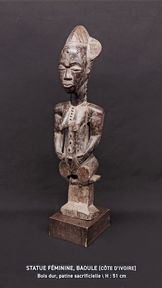
A collector in search of meaning
In 1968, Francis Réveillaud traveled to Kinshasa, approached by Pierre Fannoy and Pierre Davister about the establishment of a Belgian television channel. This study trip was a revelation. Seduced by the country's energy, he returned in 1970, this time as a decorator and industrialist. There, he founded a contemporary furniture factory, which he would run for over twenty years, forging deep ties with Africa and its crafts.
It was in the aisles of the securities market—or "thieves' market," as the gossips called it!—that he first encountered ancient raffia fabrics, vestiges of ancestral know-how. Their use goes beyond mere clothing: they are a form of currency, a social marker, and the imprint of an art that spans the centuries. Fascinated by these textiles and their symbolism, he immersed himself in their study, much to the astonishment of those around him.
His quest for understanding led him to meet Brother Joseph-Aurélien Cornet and Charly Hénault, key figures in the history of African art. They imparted to him valuable knowledge of Shoowa textiles and statuary art, refining his vision and igniting his passion.
His evenings unfold to the rhythm of meetings with merchants and antique dealers, exchanges rich in long palaver, silent information from these witnesses passing through time.
Over the years, he patiently assembles a collection, not out of a simple desire to accumulate, but in a search for meaning. Each Shoowa textile is for him a language, a tangle of repeated patterns, labyrinthine signs, graphic enigmas to decipher. This repetition, this structured balance, resonates with his temperament as an assembler, where art and history come together in a silent dialogue.













